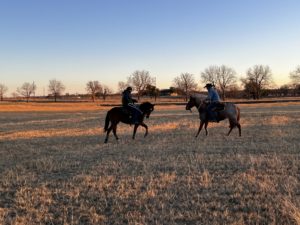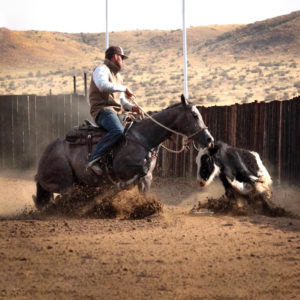
Cutter Jordan Skeith and William Turner training horse on a horse as the “cow”.
Cows are a costly, but necessary, part of a cow horse training operation. Many riders have come up with unique ways to get the job done without involving thousands of dollars in truck loads of cattle. Ultimately, you need some cows but sometimes any live animal will do the trick. Enterprising riders have used goats, yaks, humans and even other horses to train on.
North Dakota rancher Derek Mott, who is also a farrier and Facebook personality, works his horses on other horses.
Cow horse trainers Benny Guitron and Donnie Bricker showed him how.
To do this, many people put a horse in a shadow box and work it outside the fence similar to a live flag but Mott’s method involves two riders, one on the horse being trained and the other on the horse acting as the “cow”.
“It gives them something other than a flag to focus on,” Mott said.
He said when you’re teaching young horses to go down the fence you use a lot of cattle. But a horse can be used instead and they don’t tire as quickly as cattle.
“Where it really shines is taking an older horse that is a little sour with a non-pro or really leaning in the circles and doesn’t have rate,” said Mott.
Mott said working horses in place of cows has to be cautiously done. It is really a great tool to play with pressure in different areas of the horse and get them broke on the circle or hooked up to a living animal.
“It’s a great tool. A lot of people see [horses being worked in place of a cow] and go wild and start chasing other horses. That can create bad habits in your broke horses…”
When the rancher has an older horse that pushes on the bridle or pushes on a cow, he finds that he can focus on fixing those issues going side by side with another horse. He will even work a horse in the field if need be. Fences are not required for this method.
“It gives you that opportunity to push that younger horse or spoiled horse back into position and really get them to hunt that perfect spot on a cow without going through cows,” Mott said.
It’s also a handy method because you don’t have to sort cows out between works and bring them back from the end of the arena. Both horses can be pulled up, schooled and then it’s easy to carry on. Working equines with equines is a part of Mott’s program, not just a quick fix to a cattle shortage.
Justin Martin from Gainesville, Texas has bravely experimented with many different creatures all to varying results.
“llamas got mad and charged or spit at us when in range (the range is surprisingly far). Horses didn’t care for them and neither did I. So once was enough!” said Martin.
Goats are fast, he said. “We set up barricades in the round pen to slow them down and the horses really got sharp on rating their stops. Goats probably last about twice as long as a cow. They will eat anything and really clean a fence row up to the point of their own escape which leads to the eating of things you really didn’t need eaten. Bonus: the dairy crosses pull double duty in hard times!” Martin said.
He even worked his younger siblings (and later in life his own children). It actually worked well for a short time.
“Kids tend to not have the energy and stamina, while under commands, that they seem to have at bedtime and no amount of sugar could trick the mind into the durability for our training needs,” he said laughing.
“I did however develop verbal cues on them that made most stock dog trainers proud. There’s nothing like yelling: “Come By” or “That’ll do” to your kids at a soccer/ basketball game!”
He felt that over-all, the horses got better in one way or another but they had to figure out ways to keep them accurate in maneuvers so they would still show well on a cow otherwise they would miss a solid stop and really cheat a turn.

Wing training on the yak down the fence. Photo Credit: Mackenzie Wing Photography
JD Wing grew up around horses. Both of his parents trained horses and Wing has continued on that path training cow and rope horses. In a wild turn of events, Wing found himself in possession of a yak when he lived in Pueblo, Colorado. Wing lived on a 6,000 acre ranch that was part of a larger 125,000 acre holding. The ranch was so big it had its own dedicated exit. He said people would dump all kinds of things at that exit because they thought no one would notice. Near the ranch was a ranchette neighborhood and the occupants had all sorts of animals.
One day a farmer called Wing and asked if he was missing any cows. He wasn’t but the farmer said there was a really ugly cow down by the exit. Wing went to check it out and he had no idea what it was.
“I couldn’t believe my eyes when I found her!” said Wing.
He roped the animal and brought her back to the ranch. Wing contacted a branding officer to figure out if it had an owner but she remained unclaimed. After a Google search using the description: ‘fury cow looking animal with pointy horns’, he realized he had a yak in his arena. After more research, he came across a ranch 30 minutes away that raised them for meat. They had pictures posted and his yak looked just like them.
He decided to try to work his cow horse on her. His wife is a photographer so they made sure to get pictures of the first time taking her down the fence.
He said she was great going down the fence until one day she just decided she was done.
“When she stopped she would back up and spin and turn like a reining horse. She would plant a back leg and spin. We thought maybe now we could cut on her,” he said.
They cut on her for two months lasting as long as two loads of cattle. He cut her everyday and one day, just like the fence work, she just gave it up and became the babysitter.
“…When she got gentle we ended up naming her ‘Truly’ because I was drinking a Truly when I found her,” Wing said.
“She would meet you at the gate and lead all of the cattle in and keep them in the middle. She was really good,” Wing said.
He said the horses just thought it was an ugly cow but, “She felt more like a buffalo to me. She would stand there and hold her ground and when she did move she was gone. She never leaned on me. That was one thing I really liked about her. I could stay away from her and get her turned…When she did move, she did it fast.”
Wing believes she was pretty old but she stayed fit, ate well and never got sick. Truly the yak passed away after about two years of service in the arena.
